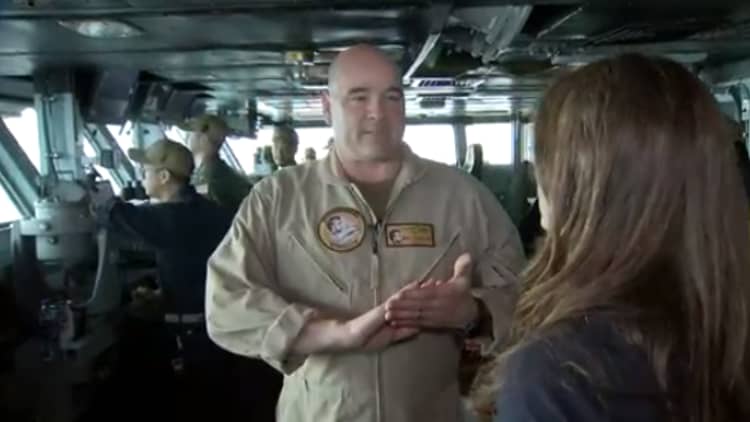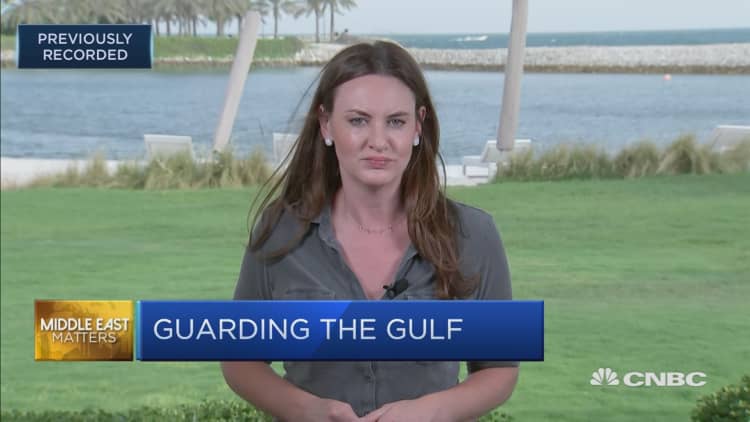
MANAMA, Bahrain — America's growing volume of military assets in the Persian Gulf is about deterrence, not war, senior Navy commanders told CNBC aboard the USS Abraham Lincoln.
"Our goal is not to go to war with Iran. Our deterrence seeks to add to stability in the region, freedom of movement, and trade," Capt. William Reed, the air wing commander on the carrier, told CNBC's Hadley Gamble over the weekend.
The U.S. aircraft carrier, currently in the North Arabian Sea, is a "great symbol of American presence in the Gulf, which in turn adds stability to the region," Reed added. He oversees 77 aircraft associated with the strike group.
But his forces are ready to go, and this sentiment is readily displayed on the flight deck aboard the USS Abraham Lincoln which hosts a total of 44 different strike fighters as well as helicopters, among other aircraft.
The U.S. Navy's 5th Fleet is tasked to protect and patrol an area of about 2.5 million square miles of water. Responsible for naval forces in the Persian Gulf, Gulf of Oman, Gulf of Aden, Red Sea, and the Arabian Sea, the Fleet's work has seen increased importance in recent months.
Six commercial oil tankers were damaged near the entrance to the Persian Gulf in May and June in suspected attacks that Washington has blamed on Tehran. On June 20, Iran shot down a U.S. spy drone, prompting the President Donald Trump administration to prepare a military strike on the country that Trump claims he called off with 10 minutes to spare.
Protecting the world's oil flow
The events sent oil prices temporarily upward, and highlighted the vulnerability of the resources flowing through the vital Strait of Hormuz. The strait remains a strategically important choke point, where shipping lanes narrow to just a few miles across and from which 20% of the world's oil supply transits from many producers, including the region's largest, Saudi Arabia, mostly to Asian markets.
The captain noted that the 21 million barrels of oil traveling through the strait each day is a global issue, not just an American issue, and this is at the heart of the U.S.'s role in the region. Trump has even tweeted his concern over America's role in protecting the strait and the oil that passes through it, saying on June 24 that the recipients of that crude should be protecting their own ships.
The U.S. is using its own assets to make sure that the free flow of commerce and trade is unimpeded, Reed said, adding that it isn't doing this alone but is the one providing deterrence. "We are ready to go, do that presence mission, in order to deter and not go to war with Iran."
The Iranians see it differently. Responding to the increased U.S. presence in the Gulf, Tehran has pointed the finger of blame at Washington for what it says is more regional instability, not less.
"(The) Persian Gulf is a vital lifeline and thus nat'l security priority for Iran ... any extra-regional presence is by definition (a) source of insecurity," Iranian Foreign Minister Javad Zarif tweeted on Friday. "Iran won't hesitate to safeguard its security."

But to Capt. Walter Slaughter, the USS Abraham Lincoln's commanding officer, it's all about deterrence and the power the strike group has in the region. He oversees 5,400 crew stationed on board, and a carrier from which 80 to 90 flights take off and land each day.
"It's 4.5 acres of U.S. sovereign territory that I can park anywhere in the world. What goes on in the Strait of Hormuz, we are kind of the 911 force if something were to happen."
With the ability to travel up to 30 plus knots, or approximately 35 miles per hour, the carrier could reach the Strait of Hormuz in no time. The carrier hasn't ventured that far north just yet, but would be ready to if called upon, Slaughter told CNBC. Although the U.S. presence so far hasn't stopped what experts describe as escalatory acts by Iran, he's fairly certain they know the Americans are there, and they are watching.




